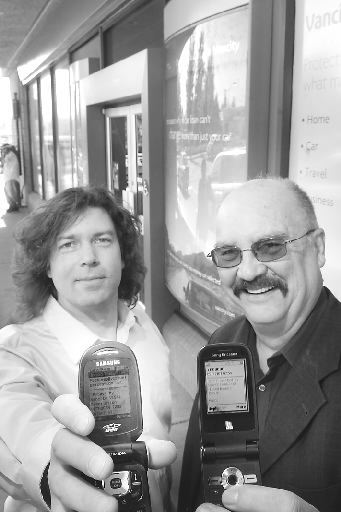Software takes 30 to 90 seconds to give notification of an ATM withdrawal and balance left
Marke Andrews
Sun

Darren Stevens (left) and Gordon Ross, partners in Virtual Perception Systems Inc., show MySpy notifications received on their cellphones outside a Vancity branch. Stevens was the victim of ID theft at Delta’s Scottsdale Centre Mall. Photograph by : Ian Lindsay, Vancouver Sun
When Darren Stevens became a victim of identity theft last March, he was notified almost immediately on his cellphone by MySpy, software he and business partner Gordon Ross had invented.
Problem was, he didn’t have his phone with him that night, so he only learned the next morning that someone had taken $200 out of his bank account through a Lower Mainland ATM.
Lesson learned: Stevens now keeps his cellphone close by.
“If I had my cellphone with me that night, I could have called the police and given them the bank machine number, and they could have sent a car over and picked someone up while the crime was in progress,” said Stevens, who believes more illegal withdrawals were made at the same ATM that evening.
The identity theft occurred at Delta’s Scottsdale Centre Mall, where thieves stole information from a debit-card machine and duplicated credit cards. Stevens wasn’t the only victim — more than 100 people were robbed through the scam, some losing as much as $1,000 –but he was the only one with MySpy, which not only notified him about the withdrawal, it gave the location of the ATM where the illegal transaction occurred.
Through their company, Virtual Perception Systems Inc., CEO and chief system architect Stevens and president Ross developed MySpy and launched it last March. For a $19.95 annual fee, users download the software to their computer, cellphone or BlackBerry from my-spy.com., and register which bank or credit-card accounts and which institutions they want to monitor. All client information is secure and encrypted to prevent it from being hacked. Whenever a debit happens on any of the client’s accounts, the client receives a notice within moments listing the size of the transaction, where it occurred (including the location of an ATM), and how much is left in the account. If the client has a cellphone, the message goes to the phone, and they would be notified by whatever message tone they use.
Notification of an ATM withdrawal takes 30 to 90 seconds to show up, depending on your network servers. Use of a credit card can take up to 24 hours, depending on the clearing house that posts transactions.
Contacted at his Delta home office, Ross said he and Stevens met with the RCMP two years ago to discuss other crime-fighting software.
“We had some high-end, CIS software that was location-based,” said Ross, who in 1994 developed Net Nanny, the first Internet filter. “They recommended we start looking at the financial institution issue. So we put our other things on hold, took the underlying technology, and started working on MySpy. We felt it was important because of the whole issue of ID theft and financial fraud that’s going on.”
Since launching MySpy in March, Virtual Perception Systems has been building its client base, but banks and credit unions have been slow to accept it, a fact that puzzles Stevens. “I don’t know why they’re not jumping on it, because this is really a win for them as well,” said Stevens. “We’re looking to refine our message and let them know what they need to do to monitor the use of MySpy, partner with us and push it out to their members.”
RCMP spokeswoman Const. Annie Linteau said the idea is a sound one.
“Anything that would enable someone to find out right away that they’ve been defrauded would be an asset, because often it is weeks before people know,” said Linteau. “You could call your credit card company or the bank card company or the police right away.”
© The Vancouver Sun 2007

